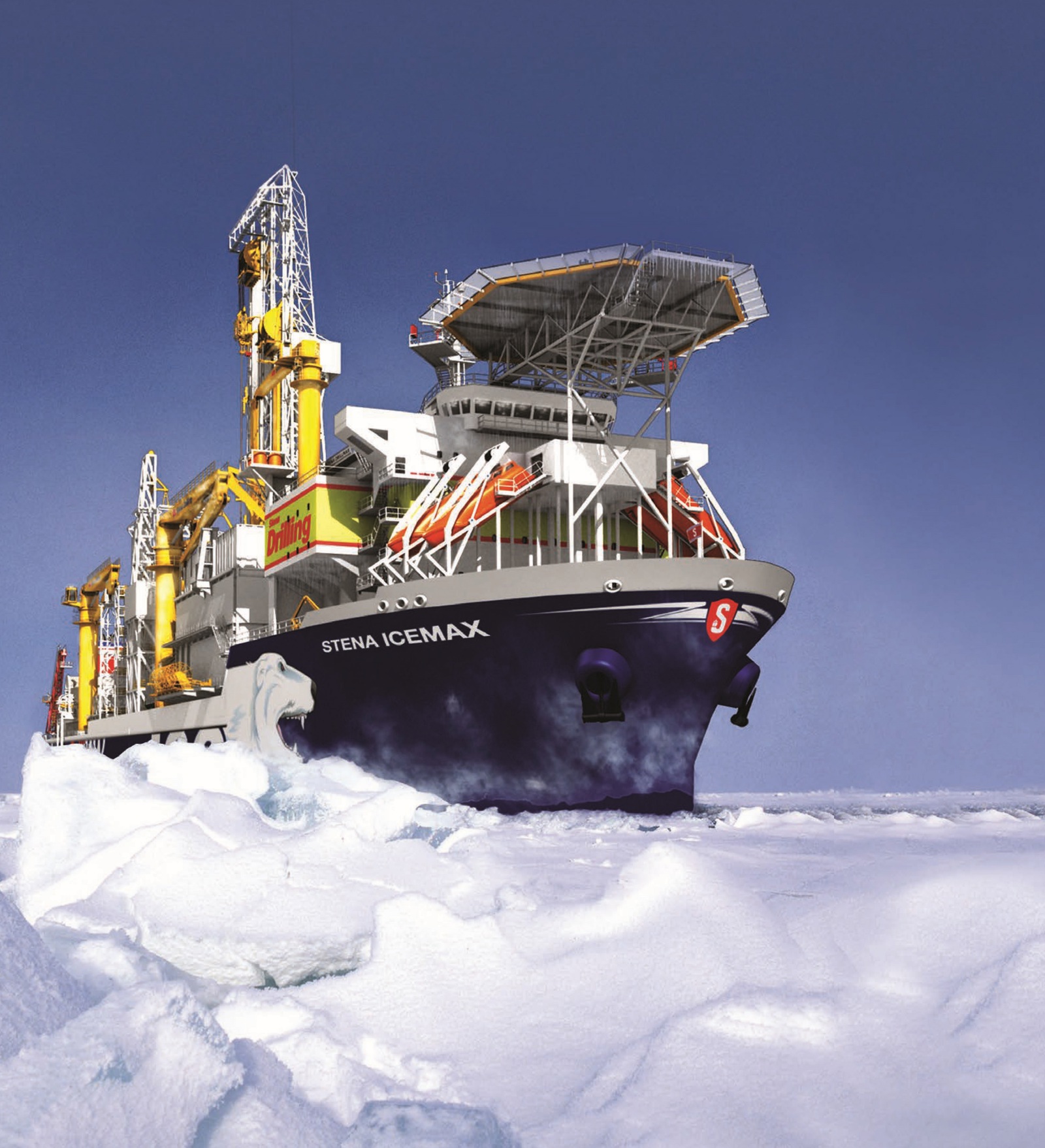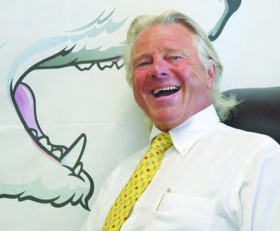
From the icy waters of the Arctic to the deep waters off the coast of Brazil, Stena’s new drillship now under construction at Samsung Heavy Industries can drill in almost any sea conditions and at depths down to 3000 meters.
-
Text:Kongsberg Maritime Communication
-
Gunvor Hatling MidtbøVice President, Communications
Scheduled for delivery in April 2012, the most recent addition to Stena Drilling’s fleet will be the industry’s first ice class +1A1 dual-mast ultra deepwater drillship built for arctic conditions. According to Tom Welo, Managing Director of Stena Drilling, the project was conceived to meet the evolving demands of the industry.
“Increased global demand for oil has encouraged energy companies to focus more on exploration,” he says. “And since many of the most promising fields are increasingly found in deepwater and harsh environments, including the Arctic, we saw an opportunity to build a drillship optimised for the new marketreality.”
Welo acknowledges that IceMAX represents a significant investment for the company: “Any newbuilding project built on spec is a risk, but in our view, the greater risk would be to sit still,” he says. “We anticipate continued growth in this segment, and want to strengthen our position as a leading provider of deepwater drilling units equipped to operate in harsh environments.”

Tom Welo, Managing Director, Stena Drilling - Welo believes that the ‘new market reality’ of tapping into harder to reach resources opens up opportunities for innovative ships such as the Stena IceMAX.
PROVEN DESIGN
The DrillMAX ICE is based in part on Stena's DrillMAX design, first developed in the early 2000s. The DrillMAX series of Stena drillships, which include Stena Carron, Stena IceMAX, and Stena Forth, have modified hulls to accommodate Stena Drilling's unique NOV hydraulic cylinder drill package. Also, the series is equipped with a number of fully automated applications including ballast discharge, mud systems and dynamic positioning (DP3) to maximise ease of operation. The two-mast system provides greater flexibility allowing the ship to work on both the blowout preventer (BOP) and top-hole drilling at the same time.
But according to Harry Rostad, Lead Instrument & Electrical Engineer for the Stena Ice Project, the IceMAX required some special modifications: "The basic design is the same as previous DrillMAX vessels, but making the drillship suitable for arctic operations resulted in a number of important changes," he says. "For example, the vessel design provides deck workers improved protection against the environment and the hull is re-enforced with a band of steel between 6.5 and 14 meters above the baseline to ensure hull integrity in icy seas."
MODIFIED FOR ARCTIC DRILLING
Other modifications include special power management, propulsion and anti-icing systems. Powered by six ice-classed 5.5MW azimuth thrusters, IceMAX has two designated moon pools port and starboard to allow for installation of two separate ROV systems. Anti-icing equipment protects the unit's helicopter deck, deck piping, lifeboat escape exits, ventilation intakes, scuppers and drains while enhanced de-icing machines keep decks, gangways, and handrails clear.
IceMAX also has expanded crew areas, to accommodate meteorological scientists and ice management teams: "Structurally, we added conning stations both port and starboard to allow the DrillMAX ICE to be piloted from three different locations," says Rostad. "At the same time, the anti-icing systems required that we work with suppliers and the yard to ensure these systems were seamlessly integrated with the power supply."
ARCTIC INNOVATIONS
Rostad notes that in order to comply with ice class +1A1 classification, all electrical cables have been tested and approved to function at -40°C. For example, the company worked together with Samsung and lighting provider Glamox to develop LED lights for outside use: "We discovered that traditional florescent lights do not work properly at temperatures below -30°C, and the anti-icing system design is a result of detailed laboratory testing in various low temperatures and wind conditions in order to be sure that the anti-icing is fit for purpose," he says. "All this extensive testing resulted in new types of handrails, heated walkways and light fixtures among other features."
BUILDING LONG-TERM RELATIONSHIPS
Stena worked with a broad range of suppliers to get results. In addition to Samsung, a leader in drillships, key suppliers on the project include NOV, supplier of drilling equipment, Knuckleboom (deck cranes rated for -30°C conditions), DNV (class services), Cameron (six-RAM BOPs) and Kongsberg Maritime, which provided bridge control, drill control, DP3 station-keeping systems and related automation.
Ivar Vebostad, Project Manager (Drilling) for Kongsberg, says that the project has gone well: "Our close relationship with Samsung and years of experience with Stena – including our work on the three previous IceMAX vessels – has helped the project move forward on schedule," he says. "We have been working with each other on these vessels over the past seven years, so we all know each other well, and have learned to anticipate each other's needs."
“With this unit, we can offer the flexibility to go anywhere and drill at almost any depth”
SHARING INFORMATION
Hans-Christian Hagevik, site manager for Kongsberg who has been working on the IceMAX vessels at Samsung for the past five years, says that the project has helped the company understand some of the practical issues related to operations in Arctic conditions: "Operating safely in icy seas and low temperatures, which can drop to -20°C degrees in summer, is challenging," he says. "So in addition to modifying the power management system to support anti-icing equipment, we have also had to develop wind sensors that can withstand -35°C temperatures and install an additional INMARSAT system to ensure accurate readings on the DP systems. Redundant references systems are critical to the integrity of DP3 systems, especially in the Arctic, where the quality of satellite coverage varies."
While Hagevik is quick to note that Kongsberg has supplied systems to many vessels trading in harsh conditions, the company's practical work on the Stena IceMAX vessels has helped build its expertise in cold climate systems.
"We are very grateful to both Samsung and Stena for the opportunity to work on the IceMAX vessels, especially IceMAX, which takes an innovative design one step further," he says. "In my view, the IceMAX will be recognised as one of the most versatile, technically-advanced drillships on the market."
CALCULATED RISK
For Stena, the DrillMAX ICE represents a calculated risk. In total, costs related to adapting the IceMAX unit for Arctic conditions add up to somewhere between USD 220 to 240 million. And while the company is already in dialogue with a number of energy companies that have expressed interest in the concept, the drillship does not yet have a charter agreement.
But Stena's Managing Director Tom Welo remains confident the unit will attract a charter soon: "The IceMAX will be delivered at a time when energy companies are expanding their deep and ultra deepwater exploration programmes, and offshore drilling in the Arctic is attracting more interest," he says. "With this unit, we can offer the flexibility to go anywhere and drill at almost any depth."